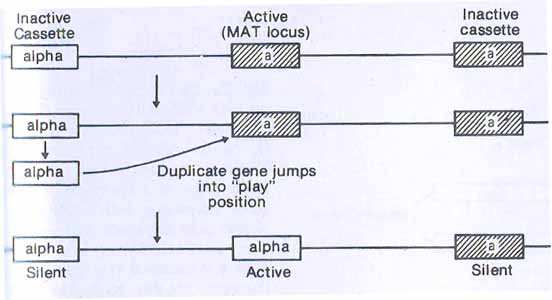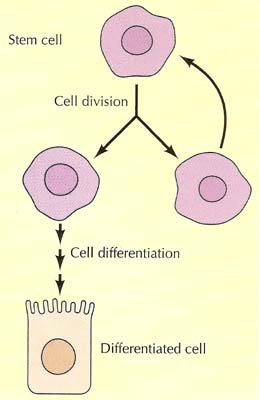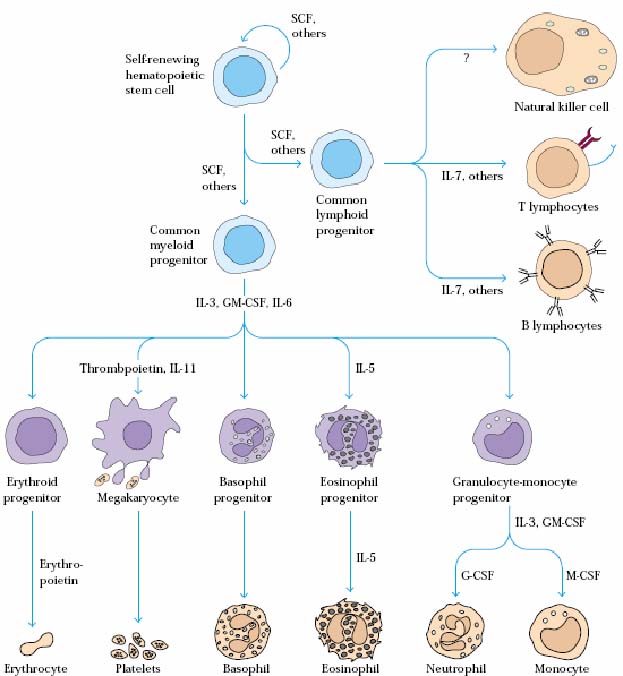
CELL DIFFERENTIATION
Cell differentiation is the process by which stable differences arise between cells. All higher organisms develop from a single cell, the fertilized egg which gives rise to the various tissues and organs. Formation of tissues and organs are only possible because of cell differentiation process. In molecular terms, cell differentiation means variable gene activity in different cells of the same organism. Cell specialization involves the preferential synthesis of some specific proteins e.g. hemoglobin in erythrocytes and antibodies in plasma cell. Each eukaryotic cell expresses only a small percentage of the genes it contains and cells of different tissues express different sets of genes. Not all genes, however, tissue specific. Some genes are expected to be active in all types of cells; they are called as housekeeping genes. Examples of housekeeping genes are those required for building membranes, ribosomes and mitochondria etc. The genes that are expressed differentially are called as luxury genes. Example hemoglobin and immunoglobin genes.
Cell differentiation process might be understood with the simple example of embryo development. In most animal species females produce large unfertilized eggs that contain most of the materials and nutrients required to form an embryo. Development is triggered by fertilization. The sperm contributes a small, condensed nucleus (male pronucleus), which rapidly enlarges in the egg cytoplasm, fuses with the female pronucleus, and finally divides. The fertilized egg then undergoes a series of very rapid cycles consisting of DNA synthesis followed by cell divisions. These divisions are called cleavage, because, unlike normal cell division, the cytoplasm is partitioned without growth. Then the cells form a hollow sphere called as blastula in which tissues are not yet evident. Some of the cells then invaginate in a series of cell movement known as gastrulation and the first signs or morphological differentiation appears. This complex changes takes place in a comparatively short time. These events can be represented as cell differentiation process. For example, in the South African frog, Xenopus laevis, a swimming tadpole containing most differentiated tissues formed only 72hours after fertilization.

CHARACTERISTICS OF CELL DIFFERENTIATION
There are four characteristics of cell differentiation. They are
1. It is stable phenomenon
2. It is induced by specific stimuli
3. It precede morphological difference
4. It is controlled by genetic factors
1. It is stable phenomenon
One of the principle characteristics of cell differentiation in higher cells is that once established, the differentiated stat is very stable and can persist throughout many cell generations. For example, a neuron will persist as such throughout the lifetime of an individual.
2. It is induced by specific stimuli
Another important characteristic of cell differentiation is that it is induced in the organism by various stimuli but once it has been established, it can persist even in the absence of the initial stimulus. For example, differentiated cloned cell lines, such as steroid-secreting cell lines are able to grow indefinitely in vitro. The differentiated state is maintained over many cell generations.
3. It precede morphological difference
In many cases before morphological difference appears, the cell is committed to a particular change due to cell differentiation process. The best example of determination is provided by the imaginal discs of Drosophila. When the discs were transplanted in Drosophila to different parts, they give rise to its original morphology irrespective of its transplantation.

4. It is controlled by genetic factors
Genes (genetic factors) enacted crucial role in controlling and executing cell differentiation process. This was clearly shown by mutational studies. Certain genes are called as homeotic genes, which when inactivated change one segment of the fly into another e.g. haltere into wings or an antenna into a leg. The fruit fly, Drosophila melanogaster development may be conceived as a series of binary divisions in which selector genes are switched on or off, giving rise to the different segments of the fly and then to smaller compartments within each segment. Each selector gene modifies the activity of entire sets of other genes. A conserved protein-encoding segment of 180 nucleotides, the homeobox, has been found in several Drosophila homeotic genes. These genes code for DNA-binding proteins, which are involved in controlling the early differentiation of the embryo. Homeobox-containing genes have been isolated from vertebrates and this may provide key to understanding development and differentiation.
TYPES OF DIFFERENTIATED CELLS
The cells of adult animals can be grouped into three general categories with respect to cell proliferation and replacement. A few types of differentiated cells, such as cardiac muscle cells in humans, are no longer capable of cell division and cannot be replaced if they are lost due to injury or cell death. These cells are produced during embryonic development, differentiate and are then retained throughout the life of the animal.
Second types of differentiated cells retain their ability to proliferate. These cells enter the G0 phase of the cell cycle but resume proliferation as needed to replace cells that have been injured or have died. Cells of this type include liver cells, skin fibroblasts, smooth muscle cells and the endothelial cells of blood vessels etc.,
In third group cells, most fully differentiated cells, however, are no longer capable of cell division but can be replaced by the proliferation of less differentiated cells, called stem cells, that are present in the tissues of adult animals. Because they retain the capacity to proliferate and replace differentiated cells throughout the lifetime of an animal, stem cells play a critical role in the maintenance of adult tissues.
DETERMINANT OF CELL DIFFERENTIATION
Mainly there are two determinants namely cytoplasmic and nucleocytoplasmic determinants.
Cytoplasmic determinants
The best example of cytoplasmic determinants is provided by the granules present in germ cells. When they are centrifuged or transplanted into different positions, they will induce the formation of germ cells in a different position. In nematode embryos these granules can be followed with monoclonal antibodies and have been observed to move to one side of the cytoplasm during prophase, so that only one of the daughter cells inherits the cytoplasmic determinants.

Nucleocytoplasmic determinants
Experiments in which a nucleus is placed in a foreign cytoplasm have provided insights on nucleocytoplasmic determinants for cell differentiation. Immortality character provided by fusion of B lymphocytes with myeloma cell lines during monoclonal antibodies production is an example for the influence of nucleocytoplasmic determinants. Frog oocyte cytoplasm is able to reprogram the expression of genes in transplanted nuclei. This reprogramming ability was found when kidney nuclei of Xenopus were injected into oocytes of the salamander Pleurodeles. The work with somatic cell fusion and with transplantation of nuclei into oocytes suggests that the cytoplasm can indeed reprogram the activity of nuclear genes.

MOLECULAR MECHANISMS
Cell differentiation might be achieved by the action of all or few or any one of the following mechanisms:
1. Transcriptional control
2. Translational control
3. Gene amplification
4. Gene rearrangement
5. Transpositions
1. Transcriptional control
Activation of transcription is probably the most common one, used in many protein-coding genes, e.g. globin in red blood cells and silk firbroin in the silk gland. Transcriptional control can be studies by isolation of nuclei from different tissues. The RNA Polymerase II molecules that had initiated RNA synthesis in vivo remain attached to the chromatin and can elongate transcription if radioactive nucleotides are added. These labeled RNAs then are hybridized to a specific cloned segments of DNA. The results from such experiments were clearly shown that transcription is tissue-specific. Chromatin structure and DNA methylation studies might also provide ample evidence against transcriptional control over cell differentiation.
2. Translational control
Translational control is known to occur in some eggs that have "masked" mRNAs that are translated only after fertilization. The best example of translational control is provided by the heat-shock mRNAs of Xenopus oocytes, which are stored but not translated unless the temperature is raised which happens only after fertilization.
3. Gene amplification
Specific genes are selectively replicated to attain a higher level of expression in a process called gene amplification. One way of obtaining differential gene activity would be to increase the number of copies of a specific gene. Ribosomal DNA amplification was observed in the oocytes of amphibians and insects. Xenopus oocytes selectively replicate their ribosomal DNA genes; a mature oocyte has 2million copies of them whereas somatic nucleus has only 900 copies. The DNA puffs of Rhynocosciara and the chorion genes of Drosophila were also amplified. In all cases, the amplified DNA is not passed on to the future cell generations. Gene amplification does not seem to be a widespread phenomenon that can be explain most cases of cell differentiation.
4. Gene rearrangement
Gene rearrangement is one of the finest processes to achieve cell differentiation which can be clearly demonstrated in the differentiation process of matured B cell into plasma cell and memory B cell. Gene rearrangement refers to the change in the order of DNA fragments in the genome. The change in the order was necessary for the expression and regulation of specific genes which are essential for different function of specific cells. Immunogloboin (Ig) gene rearrangement can be given as finest example for cell differentiation process.
5. Transpositions
Transposition means transfer of DNA fragments within a genome which results in stable changes in patterns of gene expression. Transposition of genes from "silent" site in the chromosome into an "expression" site, where they are actively transcribed occurs in the yeast mating type switch and in the trypanosomes that change periodically their surface antigens as a defense against the host's immune system. Mating type of Yeast cells become important during adverse condition for survival. Only different mating type haploid cells fused to form diploid spores. There are usually two mating types in yeast namely a and α. The genes for the two mating types, a and α, are stored in inactive "cassettes". They can be copied and inserted into the "play" site or mating type locus (MAT), inducing a switch in the sex of the yeast strain. Thus, transposition plays vital role in cell differentiation.

EXAMPLE FOR CELL DIFFERENTIATION
The critical property of stem cells is that they divide to produce daughter cells that can either differentiate or remain as stem cells. Because the division of stem cells produces new stem cells as well as differentiated daughter cells, stem cells are self-renewing populations that can serve as a source for the production of differentiated cells throughout the life.

The role of stem cell is particularly evident in the case of several types of differentiated cells, including blood cells, epithelial cells of the skin and the epithelial cells lining the digestive tract that have short life spans and must be replaced by continual cell proliferation in adult animals. In all of these cases, the fully differentiated cells do not themselves proliferate, but they are continually renewed by the proliferation of stem cells that then differentiate to maintain a stable number of differentiated cells.
HEMATOPOIESIS
The production of blood cells provides a good example of the role of stem cells in maintaining differentiated cell populations. There are several distinct types of blood cells with specialized functions: Erythrocytes transport O2 and CO2; Granulocytes and macrophages are phagocytic cells; Platelets function in blood coagulation and lymphocytes are responsible for the immune response. Requirement of specific cells from pluripoten stem cells achieved with the help of specific cytokines production. All these cells have limited life spans, ranging from less than a day to a few months, and are continually produced by the division of a common stem cell (Pluripotent stem cell) in the bone marrow. Descendants of the pluripotent stem cell then become committed to specific differentiation pathways. These cells continue to proliferate and undergo several rounds of divisions as they differentiate. Once they become fully differentiated, however, they cease proliferation, so the maintenance of differentiated blood cell populations is dependent on continual proliferation of the pluripotent stem cell.
